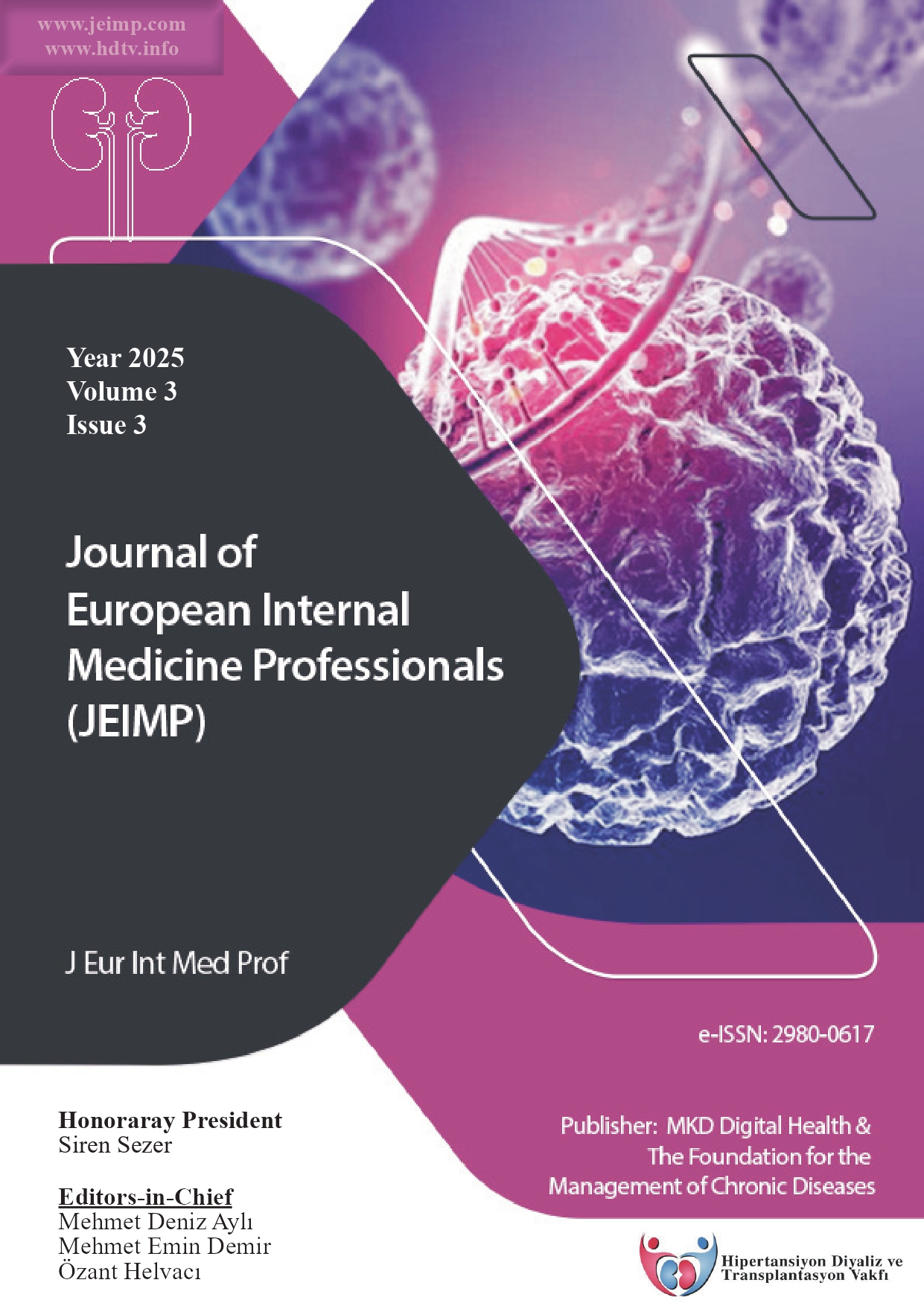Renal and Hemodynamic Effects of Sodium-Glucose Cotransporter 2 Inhibitors in Patients with Type 2 Diabetes and Chronic Kidney Disease Receiving Varying Doses of Renin-Angiotensin System Blockade
Renal and Hemodynamic Effects of SGLT2i
DOI:
https://doi.org/10.5281/zenodo.16737200Keywords:
Sodium‑Glucose Transporter 2 Inhibitors, Renin‑Angiotensin System, Diabetic Nephropathies, Glomerular Filtration Rate, ProteinuriaAbstract
Background: Chronic kidney disease (CKD) in the context of type 2 diabetes mellitus (T2DM) remains a significant global health challenge. Sodium-glucose co-transporter-2 inhibitors (SGLT2i) have emerged as a renoprotective therapy, often co-administered with renin–angiotensin system inhibitors (RASi). However, the clinical impact of background RASi intensity on SGLT2i-associated renal and hemodynamic outcomes remains unclear.
Methods: This retrospective study included 67 patients with T2DM and CKD initiated on SGLT2i therapy and followed for 12 months. Patients were stratified into three groups based on background RASi use: no RASi, moderate-dose RASi, and full-dose RASi. Clinical, biochemical, and hemodynamic parameters—including blood pressure, eGFR, proteinuria, and glycemic/metabolic markers—were evaluated at baseline, 3 months, and 12 months. Adverse events including acute kidney injury (AKI) and urinary tract infections (UTIs) were recorded.
Results: All groups exhibited significant reductions in systolic blood pressure (SBP), with the greatest decline observed in the full-dose RASi group (–13 mmHg at 12 months). A transient significant dip in eGFR was noted at month 3 in the full-dose group, with partial recovery by month 12. Proteinuria decreased significantly in both the moderate-dose and full-dose RASi groups, with the greatest absolute reduction in the moderate-dose group. Glycemic control improved across all groups, with the non-RASi group showing the most pronounced decline in fasting glucose and HbA1c. No significant differences in AKI or UTI incidence were observed among groups.
Conclusion: SGLT2i therapy is safe and effective across all RASi backgrounds. However, co-administration with RASi—particularly at full doses—appears to enhance antihypertensive, renal function, and antiproteinuric outcomes. These findings underscore the potential synergistic role of full-dose RAS blockade in optimizing the renoprotective benefits of SGLT2i in diabetic CKD.
References
Hunsuwan S, Boongird S, Ingsathit A, et al. Real-world effectiveness and safety of sodium-glucose co-transporter 2 inhibitors in chronic kidney disease. Sci Rep. 2025;15(1):1667. Published 2025 Jan 11. doi:10.1038/s41598-025-86172-y
GBD Chronic Kidney Disease Collaboration. Global, regional, and national burden of chronic kidney disease, 1990-2017: a systematic analysis for the Global Burden of Disease Study 2017. Lancet. 2020;395(10225):709-733. doi:10.1016/S0140-6736(20)30045-3
Winiarska A, Knysak M, Nabrdalik K, Gumprecht J, Stompór T. Inflammation and Oxidative Stress in Diabetic Kidney Disease: The Targets for SGLT2 Inhibitors and GLP-1 Receptor Agonists. Int J Mol Sci. 2021;22(19):10822. Published 2021 Oct 6. doi:10.3390/ijms221910822
Antlanger M, Domenig O, Kaltenecker CC, et al. Combined sodium glucose co-transporter-2 inhibitor and angiotensin-converting enzyme inhibition upregulates the renin-angiotensin system in chronic kidney disease with type 2 diabetes: Results of a randomized, double-blind, placebo-controlled exploratory trial. Diabetes Obes Metab. 2022;24(5):816-826. doi:10.1111/dom.14639
Ferrario CM, Mullick AE. Renin angiotensin aldosterone inhibition in the treatment of cardiovascular disease. Pharmacol Res. 2017;125(Pt A):57-71. doi:10.1016/j.phrs.2017.05.020
Ferrario CM, Mullick AE. Renin angiotensin aldosterone inhibition in the treatment of cardiovascular disease. Pharmacol Res. 2017;125(Pt A):57-71. doi:10.1016/j.phrs.2017.05.020
Sinha SK, Nicholas SB. Pathomechanisms of Diabetic Kidney Disease. J Clin Med. 2023;12(23):7349. Published 2023 Nov 27. doi:10.3390/jcm12237349
Cherney DZ, Perkins BA, Soleymanlou N, et al. Sodium glucose cotransport-2 inhibition and intrarenal RAS activity in people with type 1 diabetes. Kidney Int. 2014;86(5):1057-1058. doi:10.1038/ki.2014.246
Xiao F, Hiremath S, Knoll G, et al. Increased urinary angiotensin-converting enzyme 2 in renal transplant patients with diabetes. PLoS One. 2012;7(5):e37649. doi:10.1371/journal.pone.0037649
Cai Y, Shi W, Xu G. The efficacy and safety of SGLT2 inhibitors combined with ACEI/ARBs in the treatment of type 2 diabetes mellitus: A meta-analysis of randomized controlled studies. Expert Opin Drug Saf. 2020;19(11):1497-1504. doi:10.1080/14740338.2020.1817378
Tian B, Deng Y, Cai Y, Han M, Xu G. Efficacy and safety of combination therapy with sodium-glucose cotransporter 2 inhibitors and renin-angiotensin system blockers in patients with type 2 diabetes: a systematic review and meta-analysis. Nephrol Dial Transplant. 2022;37(4):720-729. doi:10.1093/ndt/gfab048
Burrell LM, Johnston CI, Tikellis C, Cooper ME. ACE2, a new regulator of the renin-angiotensin system. Trends Endocrinol Metab. 2004;15(4):166-169. doi:10.1016/j.tem.2004.03.001
Perkovic V, Jardine MJ, Neal B, et al. Canagliflozin and Renal Outcomes in Type 2 Diabetes and Nephropathy. N Engl J Med. 2019;380(24):2295-2306. doi:10.1056/NEJMoa1811744
Yang S, Zhao L, Mi Y, He W. Effects of sodium-glucose cotransporter-2 inhibitors and aldosterone antagonists, in addition to renin-angiotensin system antagonists, on major adverse kidney outcomes in patients with type 2 diabetes and chronic kidney disease: A systematic review and network meta-analysis. Diabetes Obes Metab. 2022;24(11):2159-2168. doi:10.1111/dom.14801
Seidu S, Kunutsor SK, Topsever P, Khunti K. Benefits and harms of sodium-glucose co-transporter-2 inhibitors (SGLT2-I) and renin-angiotensin-aldosterone system inhibitors (RAAS-I) versus SGLT2-Is alone in patients with type 2 diabetes: A systematic review and meta-analysis of randomized controlled trials. Endocrinol Diabetes Metab. 2022;5(1):e00303. doi:10.1002/edm2.303
Yau K, Dharia A, Alrowiyti I, Cherney DZI. Prescribing SGLT2 Inhibitors in Patients With CKD: Expanding Indications and Practical Considerations. Kidney Int Rep. 2022;7(7):1463-1476. Published 2022 May 5. doi:10.1016/j.ekir.2022.04.094
Zhuo M, Paik JM, Wexler DJ, Bonventre JV, Kim SC, Patorno E. SGLT2 Inhibitors and the Risk of Acute Kidney Injury in Older Adults With Type 2 Diabetes. Am J Kidney Dis. 2022;79(6):858-867.e1. doi:10.1053/j.ajkd.2021.09.015
Zang J, Liang J, Zhang X, et al. Short term sodium glucose transport protein 2 inhibitors are associated with post contrast acute kidney injury in patients with diabetes. Sci Rep. 2024;14(1):22937. Published 2024 Oct 2. doi:10.1038/s41598-024-74233-7
Heerspink HJL, Stefánsson BV, Correa-Rotter R, et al. Dapagliflozin in Patients with Chronic Kidney Disease. N Engl J Med. 2020;383(15):1436-1446. doi:10.1056/NEJMoa2024816
The EMPA-KIDNEY Collaborative Group, Herrington WG, Staplin N, et al. Empagliflozin in Patients with Chronic Kidney Disease. N Engl J Med. 2023;388(2):117-127. doi:10.1056/NEJMoa2204233
Kitamura K, Hayashi K, Ito S, et al. Effects of SGLT2 inhibitors on eGFR in type 2 diabetic patients-the role of antidiabetic and antihypertensive medications. Hypertens Res. 2021;44(5):508-517. doi:10.1038/s41440-020-00590-1
Heerspink HJL, Cherney DZI. Clinical Implications of an Acute Dip in eGFR after SGLT2 Inhibitor Initiation. Clin J Am Soc Nephrol. 2021;16(8):1278-1280. doi:10.2215/CJN.02480221
Lytvyn Y, Kimura K, Peter N, et al. Renal and Vascular Effects of Combined SGLT2 and Angiotensin-Converting Enzyme Inhibition. Circulation. 2022;146(6):450-462. doi:10.1161/CIRCULATIONAHA.122.059150
Zhou MS, Schulman IH, Zeng Q. Link between the renin-angiotensin system and insulin resistance: implications for cardiovascular disease. Vasc Med. 2012;17(5):330-341. doi:10.1177/1358863X12450094
Kaze AD, Zhuo M, Kim SC, Patorno E, Paik JM. Association of SGLT2 inhibitors with cardiovascular, kidney, and safety outcomes among patients with diabetic kidney disease: a meta-analysis. Cardiovasc Diabetol. 2022;21(1):47. Published 2022 Mar 23. doi:10.1186/s12933-022-01476-x
Downloads
Published
How to Cite
Issue
Section
Categories
License
Copyright (c) 2025 Bülent Demirelli

This work is licensed under a Creative Commons Attribution 4.0 International License.










